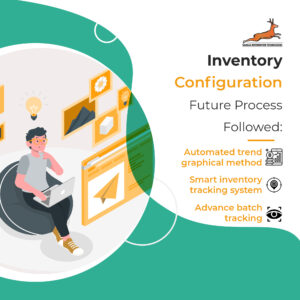Inventory Configuration
Transformation Spectrum

- PAST
- PRESENT
- FUTURE
Technology Used:
- Counting inventory
- Noting it down in physical files
Process Followed:
- FIFO
- LIFO
- Weighted average
- Specific identification
Technology sed:
- RFID
- Six sigma
Process Followed:
- Quantity on Hand (QOH)
- Minimum Stock Levels (Min)
- Maximum Stock Levels (Max)
- Average Daily Usage
- ABC analysis
- Bulk shipment
Technology to be used-
- Automated tracking technology
- AIDC
- Omnichannel

Process to be followed:
- Automated trend graphical method
- Smart inventory tracking system
- Advance batch tracking
Past
1. Technologies Used
Counting inventory – A tool within inventory management which is the physical verification of the numbers and condition of articles that are in stock.
Noting it down in physical files – Typically employs a retail staff member (or group of workers) to walk through the retailer’s sales floor and warehouse and count each item.
2. Process followed
FIFO – First in First Out. This is a method of inventory control where the first items to enter the warehouse are the first items to leave.
LIFO – Last in, first out (LIFO) is a method used to account for inventory.
Weighted average – A calculation that takes into account the varying degrees of the significance of numbers in a data set.
Specific identification – Related to inventory valuation, specifically tracking each specific item of inventory and assigning costs individually instead of group items.
Present
1. Technologies Used
RFID – Management requires a scanner that uses radio waves to communicate with the RFID tag.
Six Sigma – The Six Sigma method was originally developed to combat manufacturing defects and reduce them to an acceptable tolerance.
2. Process followed
Quantity on hand (QOH) – The calculation is very simple: the total amount that is accepted, the smaller the amount that is rejected.
Minimum stock levels (Min) – Threshold indicating the level to which actual items of material in stock are not normally allowed to fall.
Maximum stock levels (Max) – The largest number of items a business can stock to provide customer service at the lowest possible cost.
Average daily use – Calculate the average inventory by adding the beginning inventory to the ending inventory and then dividing by two.
ABC analysis – Determines the value of inventory items based on their importance to the business.
Bulk shipment – Shipping products in bulk is usually not packed but loaded directly onto the ship.
Future
1. Technologies Used
Automated tracking technology – How most modern retailers (e-commerce and others) track and organize inventory, stock, and sales.
AIDC – Automatic Identification and Data Capture (AIDC) is a broad category of technologies used to collect information from an individual, object, image, or voice without manual data entry. AIDC systems are used to manage inventory, supplies, property, security, and documents.
Omnichannel – Managing the inventory of all the channels you sell.
2. Process followed
Automated trend geographical method – Integrates all of the new techniques into a whole of analytics. Data are gathered either from on-site surveys, remote sensing, photogrammetry, and GPS techniques.
Smart inventory tracking system – An innovative way to control costs using data and powerful software to meet growing demand with less inventory.
Advance batch tracking – Is an inventory management practice in which companies can track and control the history of a group of items with similar characteristics as the items move through production and distribution channels to the customer.


